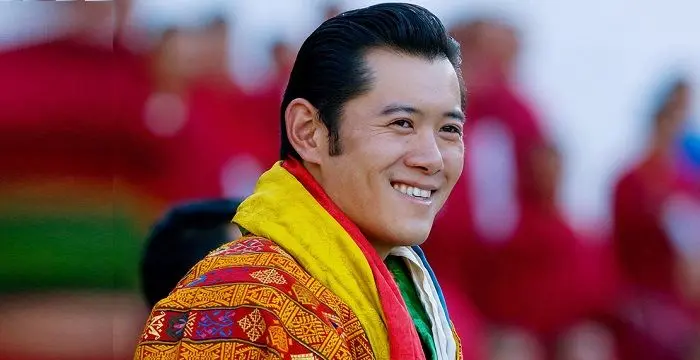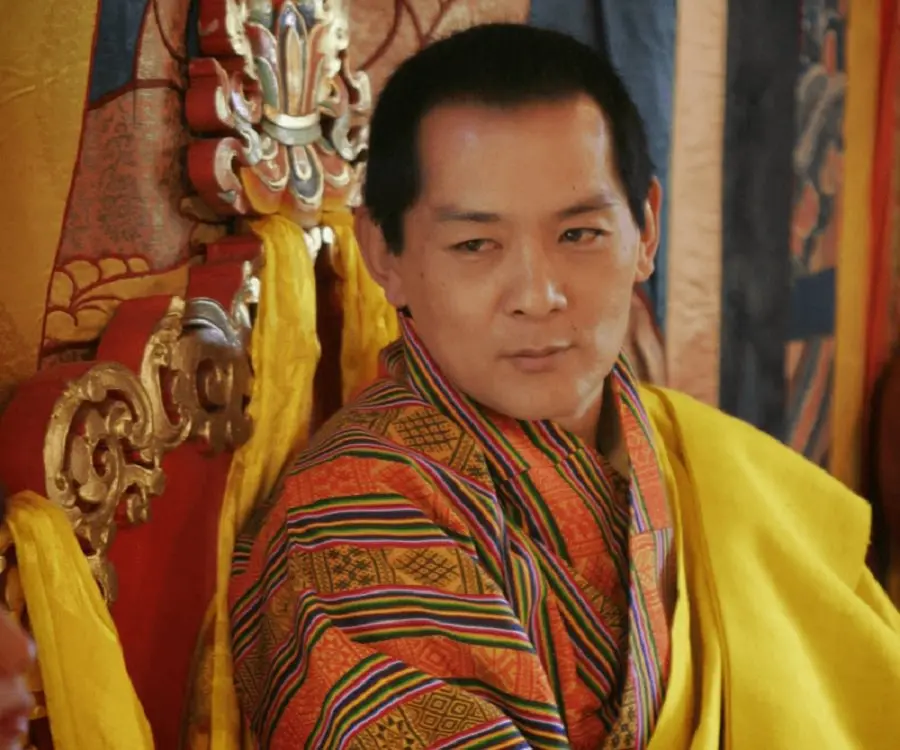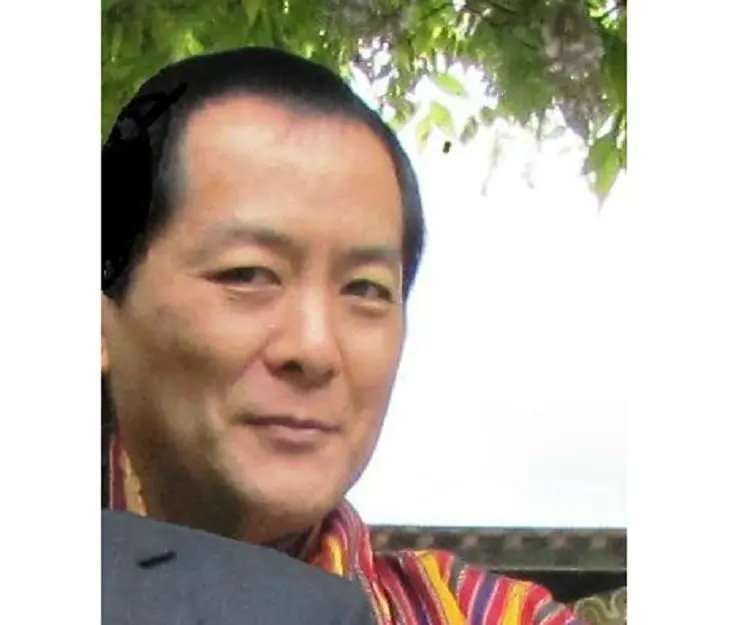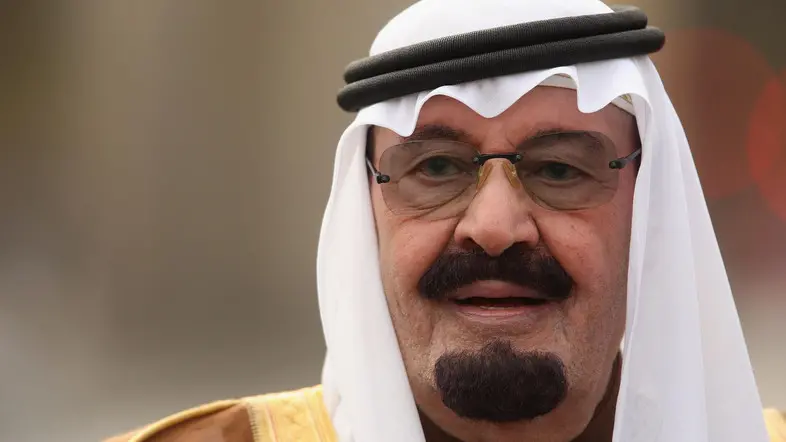
Jigme Singye Wangchuck - Former King of Bhutan, Career and Childhood
Jigme Singye Wangchuck's Personal Details
Jigme Singye Wangchuck was the King of Bhutan (Druk Gyalpo) from 1972 to 2006
| Information | Detail |
|---|---|
| Birthday | November 11, 1955 |
| Nationality | Bhutanese |
| Famous | Historical Personalities, Emperors & Kings, Leaders, Emperors, Former King of Bhutan, Kings |
| Spouses | Dorji Wangmo (m. 1979), Sangay Choden (m. 1979), Tshering Pem (m. 1979), Tshering Yangdon (m. 1979) |
| Childrens | Jigme Khesar Namgyel Wangchuck |
| Birth Place | Dechencholing Palace, Thimphu, Bhutan |
| Gender | Male |
| Father | , Jigme Dorji Wangchuck |
| Mother | Kesang Choden |
| Sun Sign | Scorpio |
| Born in | Dechencholing Palace, Thimphu, Bhutan |
| Famous as | Former King of Bhutan |
Jigme Singye Wangchuck's photo
Who is Jigme Singye Wangchuck?
Jigme Singye Wangchuck is the former King of Bhutan. He was in the throne from 1972 to 2006 before he stepped down in favor of his eldest son, Jigme Khesar Namgyel Wangchuck. Credited with bringing about many infrastructural and developmental reforms in the country, he is also known for his efforts to preserve Bhutan’s rich cultural heritage and natural environment. Born as the only son of King Jigme Dorji Wangchuck and Queen Ashi Kesang Choden Wangchuck, he received western and traditional learning in various institutions. After studying at St Joseph’s College at Darjeeling, he moved to Heatherdown Prep School in England before furthering his education at Ugyen Wangchuck Academy at Satsham Choten in Paro. Being the Crown Prince, he was appointed as the Chairman of Planning Commission in 1971. The untimely death of his father in 1972 made Jigme Singye Wangchuck the king at the tender age of 16. He continued with his father’s developmental policies upon ascending the throne and over the years built a reputation for himself as a forward-thinking monarch who tirelessly worked towards the political and economical development of the nation. He also implemented many steps to maintain the country’s rich cultural heritage and natural resources. He stepped down as the king in 2006 after abdicating in favor of his eldest son.
// Famous Emperors
Sundiata Keita
Sundiata Keita was the founder of the Mali Empire in West Africa. This biography profiles his childhood, early life, struggles, founding of empire, rule, administration, achievements and also gives some fun facts.
Ashoka
Ashoka was the third emperor of the Mauryan Dynasty and ruled almost the entire Indian subcontinent. This biography profiles his childhood, life, reign, achievements and timeline
Murad IV
Murad IV was one of the mighty Sultans in the history of the Ottoman Empire. This biography profiles his childhood, family, accession, rule, administration and timeline.
Childhood & Early Life
Jigme Singye Wangchuck was born on 11 November 1955, to King Jigme Dorji Wangchuck and Queen Ashi Kesang Choden Wangchuck at Dechencholing Palace, Thimphu, as the royal couple’s only son. He has four sisters.
His formal education began at the age of six. Later he studied in St. Joseph’s college in Darjeeling following which he moved to England to attend Heatherdown Prep School.
In 1969 he began studying at Namselling Palace before attending the newly established Ugyen Wangchuck Academy at Satsham Choten in Paro in 1970.
A teenager by now, he spent a lot of time with his father, learning leadership skills from the experienced king. In order to prepare him for future monarchy, his father appointed him as the first Chairperson of the Planning Commission in 1971 when the Crown Prince was in his mid-teens. In 1972, the young prince was assigned the symbolic rank of Trongsa Penlop, the Governor of Trongsa.
Accession & Reign
In 1972, his father, King Jigme Dorji Wangchuck died suddenly, and Jigme Singye, aged just 16, succeeded to the throne. The young king continued with his father’s reform and development policies, focusing on infrastructure, education, and health. In addition, he also implemented steps to preserve Bhutan’s rich cultural heritage and natural environment.
During the 1970s, intensive valley projects, cash crops cultivation, and enhancing the economic status of the poor became the main focus of planned development in the country. Several steps were undertaken with the aim of achieving the vision of food self-sufficiency and income generation.
The king felt that “Gross National Happiness is more important than Gross National Product,” and this became the guideline for the measurement of development in the country. Over the years, Bhutan saw unprecedented growth under the leadership of the king.
He focused greatly on infrastructural development. In 1974, there were networks of 1,332 km of roads which had grown to 4,544 km by the end of his reign in 2006. Similarly, communication and technology also grew by leaps during his reign: there were just 24 wireless stations in the country in 1974 with 480 telephone connections compared to 31,526 in 2006.
The king, deeply devoted to the welfare of his subjects promoted educational and training facilities in the nation which benefitted thousands of young students. The number of students enrolled in schools rose from a meager 13,410 in 1974 to 151,260 or so in 2006. He launched a free education policy due to which school enrolment touched 90% by 2006.
During his reign better health services, safe drinking water and better nutrition have led to an average life expectancy of 66 years. By 2006, there was 90% free primary health coverage in Bhutan. The country also registered drastic decline in infant and maternal mortality rates due to improved medical facilities.
Over the period of his 34-year reign, the national income of the nation grew manifold and Bhutan fostered friendly relations with several countries around the world. Jigme Singye Wangchuk also initiated measures to preserve the country’s rich heritage and natural resources. His environmental policies resulted in vast areas of the country being devoted to parks and sanctuaries.
He was a much loved king to his people and a respected national leader in the international arena. During the 1990s, he began taking steps to lead Bhutan towards democracy, a step that was commended worldwide.
In 2006, King Jigme Singye Wangchuk abdicated the throne in favor of his eldest son, Jigme Khesar Namgyel Wangchuck.
Major Works
In the 34 years of Jigme Singye Wangchuk’s reign, Bhutan has seen unprecedented socio-economic and cultural growth. The national income of the country, as measured by GDP, was Nu 2.4 billion in 1985. In 2006, it had increased to Nu 36.9 billion, which was a 15-fold increase in 21 years.
During his reign he focused on building strong international relationships with other countries including Bangladesh, Kuwait, Nepal, Japan, Norway, Finland, Austria, Singapore, Canada, and Thailand, among others. He also maintained close relations with India which has been Bhutan’s main development partner for the past several decades.
As the king, Jigme Singye Wangchuk initiated the process to democratize Bhutan. He relinquished absolute authority in the late 1990s and launched the Constitution of Bhutan to provide the legal framework for a democratic political system that is best suited for the nation. The Draft Constitution was released and its website was launched in 2005.
Awards & Achievements
Jigme Singye Wangchuk is the recipient of several national honors including Grand Master of the Royal Order of Bhutan (1972), Grand Master of the Order of Great Victory of the Thunder Dragon (1985), and King Jigme Khesar Investiture Medal (2008).
The foreign honors bestowed upon him include Collar of the Order of the Chrysanthemum (Japan, 1987), Member of the Order of Ojaswi Rajanya (Nepal, 1988), and Collar of the Order of Mubarak the Great (Kuwait, 1990).
Personal Life & Legacy
Jigme Singye Wangchuck got married to four brides—all sisters—in the sacred Dechog Lhakhang in Punakha on 31 October 1979, corresponding with the auspicious Descending Day of Lord Buddha.
His four wives, the queens Ashi Dorji Wangmo Wangchuck, Ashi Tshering Pem Wangchuck, Ashi Tshering Yangdon Wangchuck and Ashi Sangay Choden Wangchuck are daughters of Yab Ugyen Dorji and Yum Thuji Zam. He has ten children.
// Famous Kings
Sundiata Keita
Sundiata Keita was the founder of the Mali Empire in West Africa. This biography profiles his childhood, early life, struggles, founding of empire, rule, administration, achievements and also gives some fun facts.
Ashoka
Ashoka was the third emperor of the Mauryan Dynasty and ruled almost the entire Indian subcontinent. This biography profiles his childhood, life, reign, achievements and timeline
Murad IV
Murad IV was one of the mighty Sultans in the history of the Ottoman Empire. This biography profiles his childhood, family, accession, rule, administration and timeline.
Jigme Singye Wangchuck biography timelines
- // 11th Nov 1955Jigme Singye Wangchuck was born on 11 November 1955, to King Jigme Dorji Wangchuck and Queen Ashi Kesang Choden Wangchuck at Dechencholing Palace, Thimphu, as the royal couple’s only son. He has four sisters.
- // 1969 To 1970In 1969 he began studying at Namselling Palace before attending the newly established Ugyen Wangchuck Academy at Satsham Choten in Paro in 1970.
- // 1971 To 1972A teenager by now, he spent a lot of time with his father, learning leadership skills from the experienced king. In order to prepare him for future monarchy, his father appointed him as the first Chairperson of the Planning Commission in 1971 when the Crown Prince was in his mid-teens. In 1972, the young prince was assigned the symbolic rank of Trongsa Penlop, the Governor of Trongsa.
- // 1972In 1972, his father, King Jigme Dorji Wangchuck died suddenly, and Jigme Singye, aged just 16, succeeded to the throne. The young king continued with his father’s reform and development policies, focusing on infrastructure, education, and health. In addition, he also implemented steps to preserve Bhutan’s rich cultural heritage and natural environment.
- // 31st Oct 1979Jigme Singye Wangchuck got married to four brides—all sisters—in the sacred Dechog Lhakhang in Punakha on 31 October 1979, corresponding with the auspicious Descending Day of Lord Buddha.
- // 1985 To 2006In the 34 years of Jigme Singye Wangchuk’s reign, Bhutan has seen unprecedented socio-economic and cultural growth. The national income of the country, as measured by GDP, was Nu 2.4 billion in 1985. In 2006, it had increased to Nu 36.9 billion, which was a 15-fold increase in 21 years.
- // 2005As the king, Jigme Singye Wangchuk initiated the process to democratize Bhutan. He relinquished absolute authority in the late 1990s and launched the Constitution of Bhutan to provide the legal framework for a democratic political system that is best suited for the nation. The Draft Constitution was released and its website was launched in 2005.
- // 2006During his reign better health services, safe drinking water and better nutrition have led to an average life expectancy of 66 years. By 2006, there was 90% free primary health coverage in Bhutan. The country also registered drastic decline in infant and maternal mortality rates due to improved medical facilities.
- // 2006In 2006, King Jigme Singye Wangchuk abdicated the throne in favor of his eldest son, Jigme Khesar Namgyel Wangchuck.
// Famous Emperors & Kings
Sundiata Keita
Sundiata Keita was the founder of the Mali Empire in West Africa. This biography profiles his childhood, early life, struggles, founding of empire, rule, administration, achievements and also gives some fun facts.
Ashoka
Ashoka was the third emperor of the Mauryan Dynasty and ruled almost the entire Indian subcontinent. This biography profiles his childhood, life, reign, achievements and timeline
Murad IV
Murad IV was one of the mighty Sultans in the history of the Ottoman Empire. This biography profiles his childhood, family, accession, rule, administration and timeline.
Xerxes I
Xerxes I (Xerxes the Great) was the fourth and the most famous king of the Archaemenid dynasty of Persia. This biography profiles his childhood, family, personal life, life history, achievements, campaigns, administration, death and other facts.
Sargon of Akkad
Sargon of Akkad, also called ‘Sargon the Great’, ‘Sarru-Kan’ and ‘Shar-Gani-Sharri’, was the founder and first king of the Akkadian Empire. This biography profiles his childhood, life, rule, administration, timeline, and gives some fun facts.
Abdullah of Saudi Arabia
Abdullah bin Abdulaziz Al Saud was the King of Saudi Arabia from 2005 to 2015 and the third wealthiest head of state in the world. Find more facts about his life, childhood and timeline.
Jigme Singye Wangchuck's FAQ
What is Jigme Singye Wangchuck birthday?
Jigme Singye Wangchuck was born at 1955-11-11
Where is Jigme Singye Wangchuck's birth place?
Jigme Singye Wangchuck was born in Dechencholing Palace, Thimphu, Bhutan
What is Jigme Singye Wangchuck nationalities?
Jigme Singye Wangchuck's nationalities is Bhutanese
Who is Jigme Singye Wangchuck spouses?
Jigme Singye Wangchuck's spouses is Dorji Wangmo (m. 1979), Sangay Choden (m. 1979), Tshering Pem (m. 1979), Tshering Yangdon (m. 1979)
Who is Jigme Singye Wangchuck childrens?
Jigme Singye Wangchuck's childrens is Jigme Khesar Namgyel Wangchuck
Who is Jigme Singye Wangchuck's father?
Jigme Singye Wangchuck's father is , Jigme Dorji Wangchuck
Who is Jigme Singye Wangchuck's mother?
Jigme Singye Wangchuck's mother is Kesang Choden
What is Jigme Singye Wangchuck's sun sign?
Jigme Singye Wangchuck is Scorpio
How famous is Jigme Singye Wangchuck?
Jigme Singye Wangchuck is famouse as Former King of Bhutan








